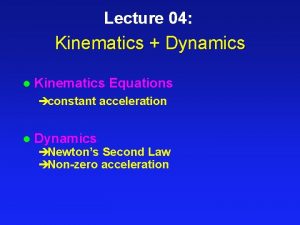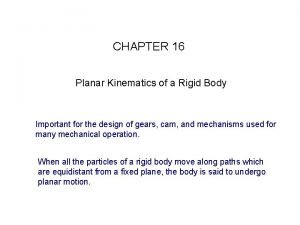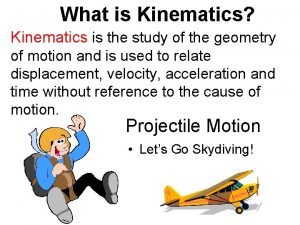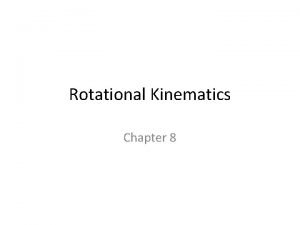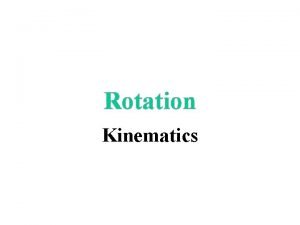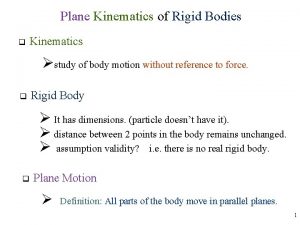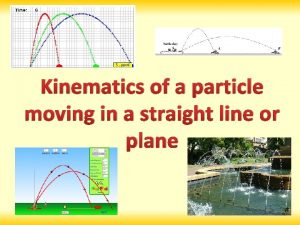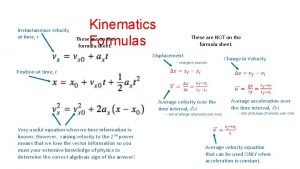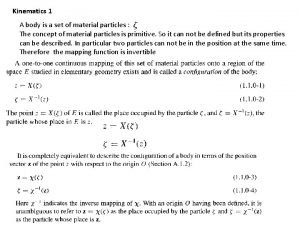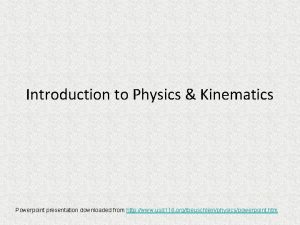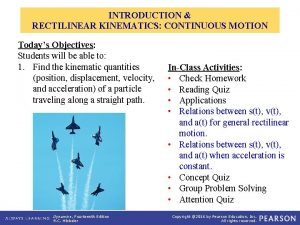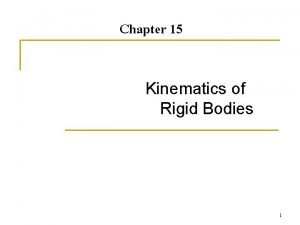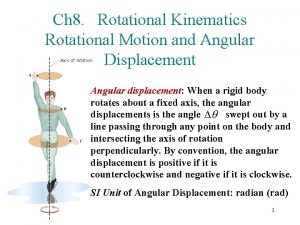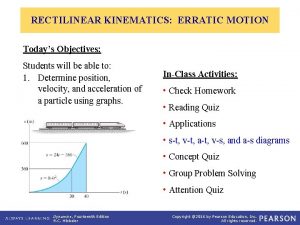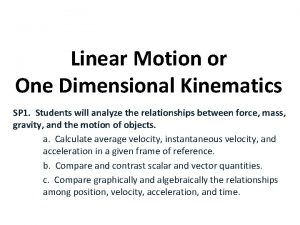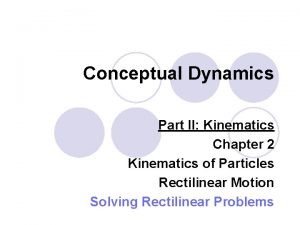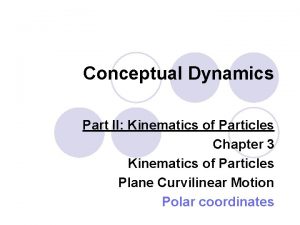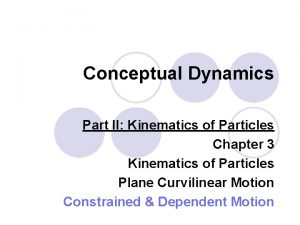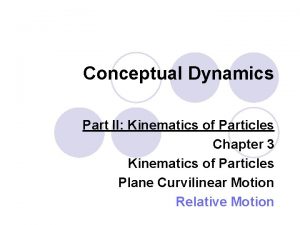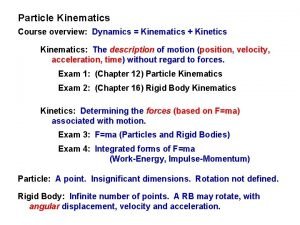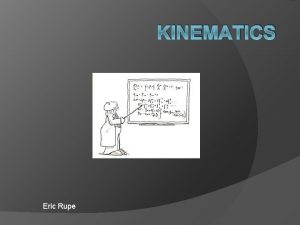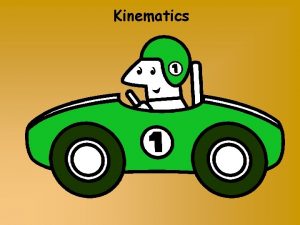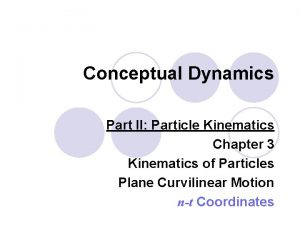Conceptual Dynamics Part II Kinematics of Particles Chapter















































- Slides: 47

Conceptual Dynamics Part II: Kinematics of Particles Chapter 3 Kinematics of Particles Plane Curvilinear Motion Projectile Motion

Projectile Motion l What is a projectile?

Projectile Motion l What is a projectile? A particle is given an initial velocity and allowed to move through the air on its own.

Projectile Motion l What is a projectile? The only force acting on the particle is its weight (if we neglect air resistance).

Falling

Falling l Video: Misconceptions About Falling Objects l http: //www. youtube. com/watch? v=a. Rhk. QT Qxm 4 w&sns=em

Conceptual Example 3. 2 -1 l All objects fall with a constant acceleration. l What is this acceleration?

Conceptual Example 3. 2 -1 l All objects fall with a constant acceleration. l What is this acceleration? The acceleration of gravity (g)

Conceptual Example 3. 2 -1 l Does mass influence a falling object’s velocity?

Conceptual Example 3. 2 -1 l Does mass influence a falling object’s velocity? No

Conceptual Example 3. 2 -1 l When would the size and shape of an object affect the speed at which an object falls?

Conceptual Example 3. 2 -1 l When would the size and shape of an object affect the speed at which an object falls? When air resistance is significant and cannot be neglected. Magnus Force Video

Solving Projectile Problems l Things to remember. 1. Motion in the x and y directions are independent.

Solving Projectile Problems l If a man shoots a bullet from the same height and at the same time that a woman shoots an arrow, which will hit the ground first? (neglect air resistance)

Solving Projectile Problems l They will reach the ground at the same time because the acceleration of falling is the same.

Solving Projectile Problems l Things to remember. 2. The x-dir velocity is constant (no air resistance).

Solving Projectile Problems l Things to remember. 2. The x-dir velocity is constant (no air resistance).

Solving Projectile Problems l Things to remember. 3. The y-dir acceleration is constant (no air resistance).

Solving Projectile Problems l Things to remember. 3. The y-dir velocity is not constant.

Solving Projectile Problems l Things to remember. 3. The y-dir position.

Solving Projectile Problems l Things to remember. 4. The y-dir velocity at the apex is zero.

Solving Projectile Problems l Things to remember. 4. If the starting height of the projectile is the same as the ending height, then the motion of the projectile is symmetric.

Conceptual Example 3. 2 -2 l What is the x-direction acceleration of a projectile?

Solving Projectile Problems l What is the x-direction acceleration of a projectile?

Solving Projectile Problems l What is special about the x-direction velocity of a projectile?

Solving Projectile Problems l What is special about the x-direction velocity of a projectile?

Solving Projectile Problems l What is the y-direction velocity of a projectile at the apex of travel?

Solving Projectile Problems l What is the y-direction velocity of a projectile at the apex of travel?

Solving Projectile Problems l What is the y-direction acceleration of a projectile?

Solving Projectile Problems l What is the y-direction acceleration of a projectile?

Solving Projectile Problems l What is important not to forget about the ydirection velocity of a projectile?

Solving Projectile Problems l What is important not to forget about the ydirection velocity of a projectile?

Conceptual Example 3. 2 -3 l Imagine that you are a passenger in one of those very tall monster trucks. The truck is driving safely at a constant speed down a long straight flat highway. Imagine that you have a ball. Now roll down the truck window and drop the ball outside of the truck. Neglecting air resistance, how does the ball behave before it hits the ground?

Conceptual Example 3. 2 -3 a) The truck quick passes the ball up. b) The ball and truck travel side-by-side and remain even. c) The ball passes the truck. d) The ball passes the truck briefly and then starts to lag behind. e) Not enough information.

Conceptual Example 3. 2 -3 a) The truck quick passes the ball up. b) The ball and truck travel side-by-side and remain even. c) The ball passes the truck. d) The ball passes the truck briefly and then starts to lag behind. e) Not enough information. Without air resistance nothing is causing the ball to slow down in the x-direction.

Conceptual Example 3. 2 -3 How would your answer change if we took air resistance into account? a) The truck quick passes the ball up. b) The ball and truck travel side-by-side and remain even. c) The ball passes the truck. d) The ball passes the truck briefly and then starts to lag behind. e) Not enough information.

Conceptual Example 3. 2 -3 a) The truck quick passes the ball up. b) The ball and truck travel side-by-side and remain even. c) The ball passes the truck. d) The ball passes the truck briefly and then starts to lag behind. e) Not enough information. With air resistance the ball is being slowed down in the x-direction and the truck remains at its constant speed.

Conceptual Example 3. 2 -3 How would your answer change if, at the moment the ball was dropped, the driver releases the gas pedal and the truck starts to coast (do not neglect air resistance)?

Conceptual Example 3. 2 -3 a) The truck quick passes the ball up. b) The ball and truck travel side-by-side and remain even. c) The ball passes the truck. d) The ball passes the truck briefly and then starts to lag behind. e) Not enough information.

Conceptual Example 3. 2 -3 a) The truck quick passes the ball up. b) The ball and truck travel side-by-side and remain even. c) The ball passes the truck. d) The ball passes the truck briefly and then starts to lag behind. e) Not enough information. This is more complex that it may appear. The truck has a higher drag coefficient than the ball, but because the truck is heavier, it has more inertia and requires a larger force to slow.

Conceptual Example 3. 2 -4 l If you drop an object, we know that its acceleration is g downward. What happens if, with all your might, you throw an object up? What’s the object’s acceleration after you let go of it?

Conceptual Example 3. 2 -4 a) b) c) d) e) Less than g. Equal to g. More than g. Less than g for a while and then g. More than g for a while and then g.

Conceptual Example 3. 2 -4 a) b) c) d) e) Less than g. Equal to g. More than g. Less than g for a while and then g. More than g for a while and then g.

Conceptual Example 3. 2 -5 l Imagine that you and a buddy are standing next to each other holding baseballs. Your buddy throws his baseball up with an initial velocity of 30 mph and you throw your baseball down with an initial velocity of 30 mph from the same initial height. Neglecting air resistance, which ball hits the ground with greater speed?

Conceptual Example 3. 2 -5 a) your ball. b) your buddy’s ball c) both your ball and your buddy’s ball hit the ground with the same speed.

Conceptual Example 3. 2 -5 a) your ball. b) your buddy’s ball c) both your ball and your buddy’s ball hit the ground with the same speed.

Example Problems EP 3. 2 -6 EP 3. 2 -7 (Video) EP 3. 2 -8
 Aplusphysics kinematics-horizontal kinematics
Aplusphysics kinematics-horizontal kinematics Kinematic equaitons
Kinematic equaitons Dynamics kinematics
Dynamics kinematics Curvilinear translation
Curvilinear translation Kinematics and dynamics of machines
Kinematics and dynamics of machines Dynamics of particles
Dynamics of particles Dynamics
Dynamics Define fluid kinematics
Define fluid kinematics Chapter 12 kinematics of a particle solutions
Chapter 12 kinematics of a particle solutions Ions charged particles in solution
Ions charged particles in solution Part whole model subtraction
Part whole model subtraction Part to part ratio definition
Part to part ratio definition Brainpop ratios
Brainpop ratios Technical description examples
Technical description examples The heart of the entire beverage operation.
The heart of the entire beverage operation. The part of a shadow surrounding the darkest part
The part of a shadow surrounding the darkest part Minitab adalah
Minitab adalah Tricycle kinematics
Tricycle kinematics What is kinematics
What is kinematics Two dimensional motion and vectors
Two dimensional motion and vectors Rotational motion equations
Rotational motion equations Rotational kinematic equations
Rotational kinematic equations Iczv
Iczv Swerve drive kinematics
Swerve drive kinematics Range motion
Range motion Dr frost further kinematics
Dr frost further kinematics Kinematics of a particle moving in a straight line
Kinematics of a particle moving in a straight line 4 kinematic equations
4 kinematic equations Kinematic equation for instantaneous velocity
Kinematic equation for instantaneous velocity Transport theorem kinematics
Transport theorem kinematics Closed form solution
Closed form solution Robot planar
Robot planar Introduction to kinematics ppt
Introduction to kinematics ppt Rectilinear kinematics
Rectilinear kinematics Rectilinear kinematics: continuous motion
Rectilinear kinematics: continuous motion Kinematics ppt
Kinematics ppt Planar kinematics of a rigid body
Planar kinematics of a rigid body Kinematics and kinetics of rigid bodies
Kinematics and kinetics of rigid bodies Fluid statics ppt
Fluid statics ppt Unit of angular acceleration
Unit of angular acceleration Kinematics
Kinematics Forward kinematics
Forward kinematics What is erratic motion
What is erratic motion Fbd and kd
Fbd and kd Nmt.ee
Nmt.ee Motion with constant velocity
Motion with constant velocity Aplusphysics kinematics-free fall answers
Aplusphysics kinematics-free fall answers Inverse kinematics
Inverse kinematics

